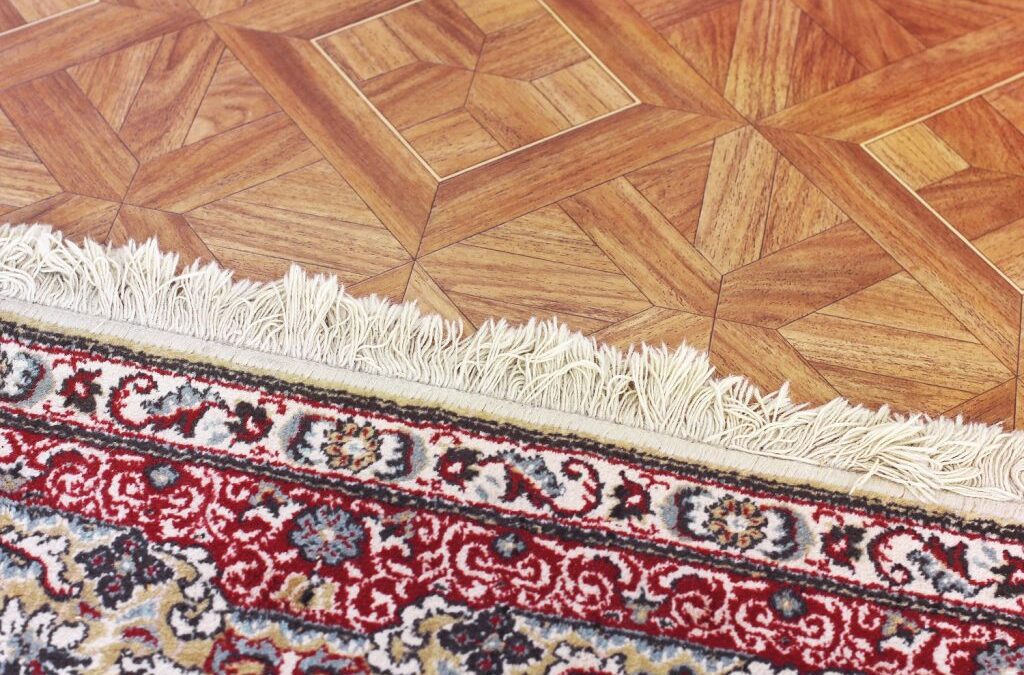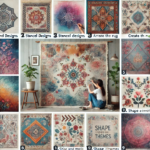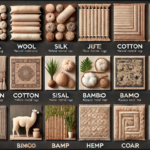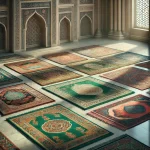The Legacy of Edgar Allan Poe and the Significance of Carpets
Edgar Allan Poe, renowned for his exploration of humanity’s darkest desires and nightmares, met a tragic end on the streets of Baltimore, clad in second-hand attire. Despite his morose tales, Poe held a passionate disdain for bad interior design, famously remarking, “a carpet is the soul of the apartment.” He deemed selecting the perfect carpet an act of genius, requiring an acute understanding of color and aesthetics.
Throughout history, carpets have held a profound significance, serving as more than mere floor coverings. In the Islamic world, carpets emerged as intricate works of art, woven by skilled artisans across various social strata. From Turkey to Persia, these Oriental rugs adorned homes and palaces alike, symbolizing wealth and status. Even nomadic communities contributed to the rich tapestry of carpet weaving, showcasing their cultural heritage through intricate designs and techniques passed down through generations.
Within royal courts, carpets transcended mere functionality, serving as ornate symbols of opulence and prestige. Their presence in palaces reflected the refined tastes of the elite and conveyed a sense of grandeur befitting of royalty.
Edgar Allan Poe’s Influence on Carpet Aesthetics
Edgar Allan Poe, celebrated for his exploration of humanity’s darkest corners and hidden desires, met a tragic end on the streets of Baltimore, clothed in second-hand garments. Despite his macabre tales, Poe held a fervent disdain for subpar interior design, famously declaring, “a carpet is the soul of the apartment.” He believed that choosing the perfect carpet required a stroke of genius, demanding a keen eye for color and aesthetics.
Throughout history, carpets have played a significant role beyond mere floor coverings. In the Islamic world, carpets emerged as intricate works of art, woven by skilled artisans across all social strata. From Turkey to Persia, these Oriental rugs adorned homes and palaces, serving as symbols of wealth and status. Even nomadic communities contributed to the rich tapestry of carpet weaving, preserving cultural heritage through intricate designs and techniques passed down through generations.
In royal courts, carpets transcended utility, becoming ornate symbols of opulence and prestige. Their presence in palaces reflected the refined tastes of the elite, imbuing spaces with an aura of grandeur fitting for royalty.
Edgar Allan Poe, renowned for his exploration of humanity’s darkest facets, met a tragic end on the streets of Baltimore, draped in second-hand attire. Despite his macabre tales, Poe held an ardent disdain for lackluster interior design, famously asserting, “a carpet is the soul of the apartment.” He believed that selecting the perfect carpet demanded a touch of brilliance, requiring a discerning eye for color and aesthetics.
Throughout history, carpets have transcended their utilitarian role, emerging as intricate works of art across various cultures. In the Islamic world, carpets became woven masterpieces, crafted by skilled artisans from all walks of life. From the bustling markets of Turkey to the palatial estates of Persia, Oriental rugs adorned homes and royal chambers alike, symbolizing wealth and status. Even among nomadic tribes, carpet weaving thrived, preserving cultural heritage through elaborate designs and age-old techniques passed down through generations.
In royal courts, carpets assumed a dual role, serving as both functional floor coverings and opulent symbols of prestige. Adorning palaces with their intricate patterns and vibrant hues, these carpets became tangible expressions of refined taste and luxury, elevating the ambiance of grandiose spaces fit for royalty.
The Ottoman Court Carpets
Among the most significant empires in history, the Ottoman Empire reigned over vast territories spanning from North Africa to Eastern Europe. Within the opulent courts of the Ottomans, carpets held a revered status, alongside the Safavid and Mughal Empires. These carpets bore intricate designs inspired by courtly art, mirroring patterns found in ceramics, paintings, and other decorative arts. Artistic finesse and sophistication were paramount, with distinct standards for carpets destined for religious or secular settings. Notably, carpets often depicted elaborate scenes of animals and hunting, both real and mythical, reflecting the cultural ethos of the era.
The British Royals and Their Carpets
Legend has it that Thomas Witty, inspired by a Turkish rug he encountered in a British market, established a carpet weaving business in Axminster, England, immortalizing the Axminster style. This weaving technique, akin to French carpets but distinguished by its vibrant colors and designs, captured the admiration of British royalty, including King George III and Queen Charlotte. Meanwhile, needlepoint rugs gained favor among the elite, as evidenced by portraits showcasing these ornate floor coverings in royal residences. From the Duchess of Windsor’s elegant living room to the grandeur of Elizabeth II’s palace, needlepoint rugs adorned the floors, epitomizing regal sophistication.
The American Rug Experience
Edgar Allan Poe, in his lesser-known essay “The Philosophy of Furniture,” critiques the American penchant for interior design, lamenting the lack of refined taste akin to European royalty. Nonetheless, the history of the American carpet industry is rich and diverse. Originating in Dalton, Georgia, the tufted carpet industry burgeoned, revolutionizing carpet production with the advent of the power loom. Early American rugs, echoing Oriental motifs, evolved into designer rugs, propelled by innovators like Edward Sands Frost. In the mid-20th century, the introduction of synthetic fibers further transformed the industry, ushering in a new era of efficiency and versatility. Today, while tufted carpets dominate the market, woven rugs endure as a symbol of authenticity and timeless elegance in homes and offices alike.
Certainly! Here’s an additional section for the article
One notable trend is the rise of sustainable and eco-friendly materials in carpet production. With increasing awareness of environmental issues, many consumers are seeking carpets made from natural fibers like wool, jute, and sisal, as well as recycled materials. Manufacturers are also exploring innovative ways to reduce water and energy consumption during production processes, further aligning with eco-conscious consumer preferences.
In terms of design, minimalist and geometric patterns have gained popularity in recent years, reflecting a shift towards clean and modern aesthetics. Neutral color palettes, such as greys, whites, and earth tones, remain timeless choices, offering versatility and compatibility with various interior styles. However, bold and vibrant colors are also making a comeback, adding personality and visual interest to contemporary spaces.
Technology has also made significant advancements in the carpet industry, particularly in the realm of smart textiles. Smart carpets embedded with sensors and data-tracking capabilities can monitor environmental conditions like temperature and humidity, providing valuable insights for building management and indoor air quality control.
Furthermore, digital printing technology has enabled intricate designs and customizations previously impossible with traditional manufacturing methods. This allows for greater creativity and personalization in carpet design, catering to diverse consumer preferences and interior design concepts.
Iwhile carpets and rugs have a rich history rooted in cultural traditions and craftsmanship, they continue to adapt and innovate in response to changing societal needs and design trends. From sustainable materials to cutting-edge technology, the modern carpet industry embraces a blend of tradition and innovation, offering endless possibilities for enhancing interior spaces with style and functionality.
Make a Smart Choice with Casa
Carpet and Tile Elevate your home décor with the perfect rug from Casa Carpet and Tile. Our extensive collection offers a wide range of designs to suit your style preferences. Whether you’re seeking elegance or cozy comfort, we have just what you need to enhance any room in your home. Inspired by Edgar Allan Poe’s notion that a rug is the soul of an apartment, let us help you infuse soulful charm into your living spaces. Contact us today to discover the ideal rug for your home.
In the intricate tapestry of history, woven carpets and area rugs have long held a place of prominence, adorning the floors of royal palaces, noble estates, and esteemed residences throughout the ages. From the opulent courts of ancient empires to the elegant halls of European monarchs, these luxurious floor coverings have not only served functional purposes but have also been prized as symbols of status, wealth, and artistic refinement.
Ancient Beginnings:
The origins of area rugs and carpets can be traced back to ancient civilizations, where weaving techniques were developed and refined over millennia. Early examples of woven textiles date back to ancient Egypt, where intricate tapestries adorned the walls of pharaohs’ tombs and royal palaces. In Persia (modern-day Iran), the art of carpet weaving flourished, with skilled artisans producing exquisite rugs that were prized for their intricate designs and fine craftsmanship.
Medieval Splendor:
During the Middle Ages, the production of carpets and rugs continued to thrive, particularly in the Islamic world. In the courts of the Ottoman, Safavid, and Mughal empires, carpets were woven as symbols of prestige and power, with designs often reflecting the cosmopolitan influences of the time. These ornate floor coverings adorned the palaces of sultans and emperors, serving as both functional floor coverings and works of art.
European Elegance:
In Europe, the tradition of carpet weaving was further refined during the Renaissance and Baroque periods. Royalty and nobility adorned their palaces and estates with lavish carpets imported from the Middle East, showcasing their wealth and sophistication. In England, the Axminster carpet style gained popularity, with its intricate designs and rich colors adorning the floors of royal residences.
Colonial Influence:
With the age of exploration and colonial expansion, the popularity of carpets and rugs spread to new corners of the globe. European traders and settlers brought the art of carpet weaving to the Americas, where it flourished alongside indigenous textile traditions. In colonial America, hand-woven rugs and carpets adorned the floors of elegant homes and plantation estates, reflecting the tastes and aspirations of the elite.
Modern Revival:
In the modern era, the tradition of carpet weaving has continued to evolve, with new materials, techniques, and designs shaping the industry. While traditional hand-woven carpets remain prized for their craftsmanship and authenticity, machine-made carpets and area rugs have become increasingly popular for their affordability and accessibility. Today, carpets and rugs continue to adorn the floors of homes, hotels, and public spaces around the world, adding warmth, comfort, and style to any interior.
Conclusion:
From the palaces of ancient emperors to the modern living rooms of today, area rugs and carpets have remained a timeless symbol of luxury and elegance. As we look back on the rich history of these exquisite floor coverings, we are reminded of their enduring appeal and the enduring legacy of craftsmanship and artistry that continues to inspire us today.






